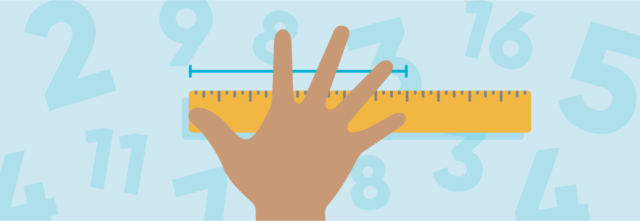
Try asking your class this question: What are ways that you’ve seen length described? You could also use the word distance. You are likely to hear a variety of standard units like inches, feet, or meters. Perhaps an aspiring astronomer in your class has heard of light years. Or you have students who grew up near water who are familiar with nautical miles or fathoms.
No matter what they say, notice the relevance of language in math class. You can represent addition and subtraction using just symbols, but that’s a lot harder to do when talking about length!
Teaching Measurement
Whether you’re a scientist measuring the distance between galaxies or you’re just trying to figure out whether a table will fit next to your bed, being able to measure length and distance is a skill that is relevant to many fields and is important throughout life.
Students as young as kindergarteners can answer questions such as “who is taller” or “which place is farther.” By third grade, students can measure down to fractions of an inch or another unit. And by fifth grade, students start converting measurements, for example from centimeters to meters. This lesson for Grades 1 and up practices measuring length using nonstandard units, where the nonstandard unit is hand spans. This lesson may also be appropriate for older students who need additional practice with measurement.
Key Standards:
- Measure length using nonstandard units (Grade 1)
- Solve problems involving measurement of length (Grades K–5)
- Attend to precision (Grades K–12)
Before the Lesson: Make a Prediction
You might want to begin by discussing statements like “3 laps around a track” or “a crater 6 football fields long” to show different ways that length can be represented. It is not always a precise measurement that you find using a ruler. Begin by having students come up with an item to measure and an object to measure with. For example:
- How wide is the computer in pencils?
- How tall is the bookcase in books?
- How long is my arm in sunglasses?
Have students start by making a prediction, for example, “I think the computer is 3 pencils long.” Then have students get up and measure! Students may need help ensuring that they are lining up objects end-to-end and doing so in a straight line. Once they’re done, facilitate a short discussion around what they observed. Take care not to call any answers right or wrong.
- Would it make sense to measure [name an item] using the same object you picked?
- Were your measurements reasonable? Call attention to what an unreasonable measurement might be, for example, “the school is 5 pencils long” or “the computer is 300 sunglasses long.”
- What surprised you?
Now connect what they just did to their hands. For the most part, using hands is nowhere near as accurate or reliable as using a ruler or a rigid, rectangular object. Historically, however, we did not need as much precision as we do now. In the book The Science of Measurement: A Historical Survey, author Herbert Arthur Klein provides a history of ancient lengths including fingernails, thumbs, and palms. It is no accident that the modern-day “foot” can refer both to a body part and a unit of length.
Even today, lengths like “hand spans” provide a way of communicating approximate lengths no matter what rulers you have access to. Think about questions like “will this box fit under my bed?” or “are the dimensions right in my drawing?” Using nonstandard measurements can even be life and death! Finger widths are a way to measure where to give chest compressions to a baby four weeks or older.
Lesson: How to Measure Hand Span
Now it’s time to have students measure using their hand spans. This is the length of your hand. To measure it, have students place their hands flat on a table, spread out their fingers as far as they can comfortably, and measure the distance from the tip of their thumb to the tip of their pinky.

This activity requires students to be able to spread out the fingers on their hand and place their hand on objects around the classroom. If you are working with students who are physically unable to engage in the activity, there are a variety of workarounds for greater accessibility. You could pair students so one student uses their hand and the other makes measurements. Alternatively, all students could use the same hand span, such as the teacher’s, which not only puts everyone on the same physical footing, but also helps with differentiation. This makes the mathematics simpler because all students are now using the same nonstandard unit of measure.
The same activity works by replacing the hand with another object like a marker or another body length such as the distance from one’s shoulder to elbow or the width across one’s neck. For students who are able, take advantage of an activity that presents an opportunity for students to get up and move around the room.
- Step 1: Provide students with a list of 3 objects in the room they can measure using their hand spans, such as a computer or bookcase.
- Step 2: Students list an additional 3 objects to measure.
- Step 3: Students predict how many hand spans each object is. They should be making a prediction for 6 objects in total.
- Step 4: Students walk up to each object and measure how many hand spans long it is. They record it in their list next to their predictions.
- Step 5: Facilitate a discussion around what the students measured. The questions below can serve as guides. Avoid calling students right or wrong, and instead call attention to similarities and differences among the students’ responses.
- What do you notice about your measurements?
- What do you wonder about measuring using hand spans?
- What other objects could we measure with our hands?
- What are other tools we could measure with besides our hands?
Extending the Lesson
This lesson focuses on lengths that are roughly the size of the human body, but the same ideas could be adapted to much longer or shorter distances. Consider questions like “how many whales wide is the ocean?” “how many pennies can stack to the Moon?” or “how many strands of hair wide is a grain of rice?” These questions require doing research and could be appropriate for older students.
Additionally, although this lesson focuses specifically on length, the same concepts can extend to area and volume. Instead of hand spans, area could be estimated using palm sizes and volume could be estimated using fistfuls. This idea gets especially fun at large or small scales. You can have students investigate questions such as “how many copies of Peru could fit inside the United States?” “how many electrons can fit into an atom?” or “how many Earths can fit into Jupiter?”
***
Looking to grow student confidence in mathematics? HMH Into Math is our core K–8 curriculum designed to create fearless problem solvers.
Get our FREE guide "Optimizing the Math Classroom: 6 Best Practices."












